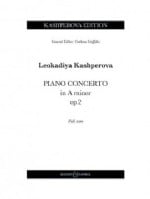Kashperova, Leokadiya (Griffiths) - Piano Concerto in A minor op. 2
Leokadiya Kashperova (1872–1940), hitherto consigned to a footnote in musical history as Stravinsky’s piano teacher, is undergoing rediscovery. A double graduate of the St Petersburg Conservatoire, she emerged as a virtuoso pianist and composer in the romantic tradition. She was associated with some of the great musicians of her day, including Balakirev and Auer. She performed in both Germany and the UK in the 1900s, but her career petered out after 1920. The Piano Concerto (1900) is Kashperova's earliest surviving orchestral work, and it was premiered by the composer the following year in Moscow and St Petersburg, bringing her much wider recognition and paving the way for an international career. Cast in three movements and in a Romantic idiom, pianistic virtuosity is often channelled into the pianist’s left hand, which is required to negotiate widely-spaced ‘extreme’ arpeggios – awkwardly angular when adagio, fiendishly technical when molto allegro. Kashperova’s orchestral colours are achieved by felicitous solos for the woodwind, horns and brass. Noteworthy, too, are unexpected glimpses of chamber music when, in the last movement for example, the piano combines fleetingly with solo violin and solo cello in passages. The concerto’s quick music (Molto allegro and Allegro con anima) admirably portrays the vivacious personality of their composer, described in 1906 as offering those around her ‘an abundance of joy, excitement and fun’. The central movement, by contrast, is a tender Adagio which offers the listener a gem of musical poetry.

